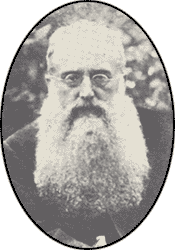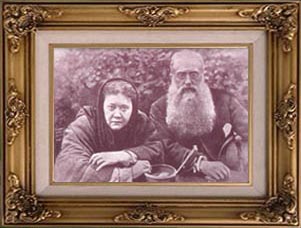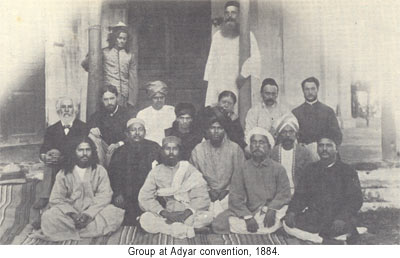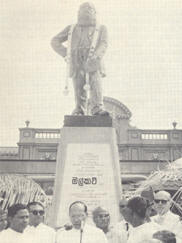|
|
Colonel Henry Steel Olcott the co-founder of the Theosophical
Society was born at Orange, New Jersey, USA on the 2nd of
August, 1832. He was the eldest child of Henry Wyekoff
Olcott and his wife Emily. The seventh generation of
the family line, after his ancestor Thomas Olcott crossed
over to the new world, some 10 years after the Pilgrim
Fathers in the May flower.
The parents were typical new world Puritans -- religious,
God-fearing devout. The mother had a reputation for
great piety in the family circles, and Henry Steel writes
lovingly of his “noble and revered parents.”
Not many details are known of the boy’s home life and
childhood. At some time the family moved from Orange
to New York City and Henry attended one of the public
schools there, he must have done very well at the school
for, at the age of fifteen, he entered New York University.
However, after a year there his formal education was
brought to an abrupt end.
|

|
Some misfortune struck Henry senior’s
business interests, and funds were not available for Henry
junior to continue at college. So at the age of sixteen,
his education incomplete, untrained for any profession,
and with no opening for him in his father’s business, young
Henry had to get out and carve some career for himself.
He moved to Ohio, near Elyria, share-farming a 50-acre plot.
Why he jumped from a university in New York and a commercial
family background to such an occupation is hard to say.
But he seems by disposition to have needed at times to make
a clean break with the old and launch out on the completely
new. He enjoyed a challenge. The pioneer blood ran strongly
in his veins.
At about this time -- to be precise, in the year 1848 when
Henry left home -- modern spiritualism made its debut before
the world. It began in a humble way at Rochester, N.Y., in
the home of John Fox.
Henry, was introduced to spiritualism by his mother’s brothers,
Edgar, Isaac, and George Steel. These men with their families
were apparently landowners and farmers in Ohio within easy
reach of Henry’s 50-acre plot. Writing in his 'Old Diary Leaves'
toward the end of his life, Col. Olcott mentions having contacted
these Steel brothers again at a later period in California,
where they had moved and become owners of large ranches. He
says, “I may almost regard them as my greatest benefactors
in this incarnation, since it was from them, and the other
bright minds and noble souls connected with them in a spiritualistic
group, that I first learned to think and aspire along the
lines which led me ultimately to H.P.B. and the Theosophical
movement.”
These realistic years close to nature, the smell of the
soil in his nostrils, the handle of the plough or pitchfork
in his hands, were perhaps better for character formation
than college education. But the obscure life of an Ohio
farmer was not to be his destiny. His brain was too active,
his ambitions too strong for that. After four or five years
of country life, he returned East to study agricultural
chemistry and other aspects of scientific farming.
After about two years of training in scientific agriculture,
a stroke of luck took Henry another step onward toward his
destiny. A relative left him a legacy. This was sufficient
for him to join forces with a fellow student of Newark and
start his own school of agricultural science. Situated near
Mount Vernon, New York it was called the Westchester Farm
School. It was based on Swiss models, and was one of the pioneers
of scientific agricultural education in America . From here
the American public began to hear the name of Col. Henry Steel
Olcott for the first time.
On the 14th of October 1874, Col. Olcott met Helena Petrovna
Blavatsky, for the first time, little realizing that the meeting
was to become a very potent factor in his life. In fact it
changed the entire course of his life.

Colonel Olcott was growing more and more unhappy about the
spiritualistic movement with which he had been connected
for over twenty years, writing, speaking and organizing.
Surely the way out of it was not back into the desert of
materialism, but rather onward and upward to the heights
of the new-yet ancient-teachings of the Great Adept Brotherhood.
On the 7th of September 1875 Colonel Olcott and Madam Blavatsky
were at a lecture, the subject of which aroused a great deal
of enthusiasm and animated discussion. The Colonel had the
idea that those present might launch a society for the study
of occult subjects. He wrote the idea on a slip of paper and
handed it to Madam Blavatsky, who nodded her head in agreement.
Whereupon, Colonel Olcott rose and after briefly sketching
the present condition of the spiritualistic movement, proposed
“to form a nucleus around which might gather all the enlightened
and brave souls who were willing to work together for the
collection and diffusion of knowledge.”
Thus on 17th November 1875 the Theosophical Society was formed.
On that date the Society held its first regular meeting, and
President-Founder Col. Olcott delivered the inaugural address.
In May 1883 Colonel Olcott and Madam Blavatsky moved to
India and had their first view of the home-to-be in India.
It was a beautiful estate on the outskirts of Madras at
Adyar. After settling there the Colonel wrote “Happy days
are in store for us here”.

The Colonel began the year 1884 with a quick
trip to Ceylon. There he persuaded the persecuted Buddhists
to form a Buddhist Defence Committee, and agreed to act as
the committee’s special envoy to the appropriate governmental
authorities in England. Through the force of his great energy,
enthusiasm and organizing abilities he brought about a revival
of the Buddhist faith. For his work he was honoured in 1967
in Sri Lanka by the Prime-minister speaking from the platform
of the Olcott memorial Society. He said:
|

Unveiling
of Olcott statute in Colombo, Feb 17, 1967. by His
Excellency William Gopallawa, Governor General of
Ceylon.
|
|
“Today we salute the memory of
a man, born an American who did yeoman service for
the cause of Buddhism and Buddhist Education in
the country”. He is revered in Sri Lanka as a national
hero, and in downtown Colombo a statue stands in
his honour.
At the Theosophical Society convention of December
1906 Colonel Olcott was not able to greet his guests
personally. Embracing old friends and looking after
the comfort of every one, presiding jovially at
table-as was his wont. He was confined to bed, with
his “left lung congested and heart dilated.” Dr.
Annie Besant had come down from Benares, now the
headquarters of the Indian Section of the Theosophical
Society to fill the role of Acting-President.
The Colonel was, however, carried downstairs to
the great hall for the opening, and Mrs. Besant
read for him his opening address. A few days later
he was carried down again to close the convention.
This was to be his last public address to an audience
of Theosophists: for it he read his first speech
to such an audience-his Inaugural Address in New
York on November 17, 1875. He read from the typed
copy given him at the Boston Public Library.
|
At the close he bade all the delegates farewell. The newspapers
described the scene thus “The delegates filed pass the venerable
old man -- Hindus, Mohammedans, Christians, Parsis – some
shaking hands, some bowing at his feet, some salaaming, according
to their various customs, all united in one sentiment of love
and reverence.”
On the 17th February 1907 Colonel Henry Steel Olcott passed
away in Adyar. At his funeral the new President elected
made an appropriate and touching funeral oration during
which she read the Colonel’s last message, signed by his
own hand, on February 2. These were his words:
To my beloved
brothers in the physical body:
I bid you all farewell. In memory of me,
carry on grand work of proclaiming
and living the Brotherhood
of Religions. |
To my beloved
Brothers on the higher planes:
I greet and come to you, and implore you to help
me to impress all men on earth that “there is no religion
higher than Truth,” and that in the Brotherhood of Religions
lies the
peace and progress of humanity. |
|
|